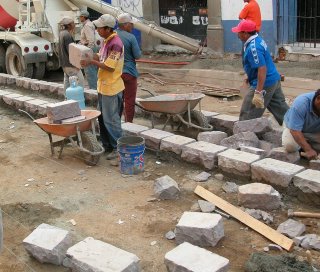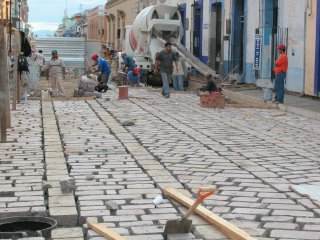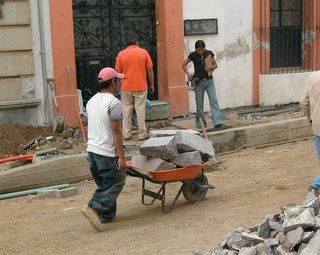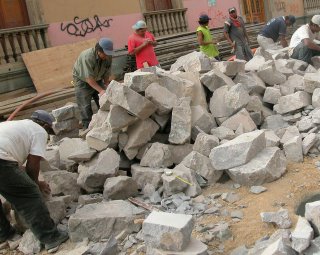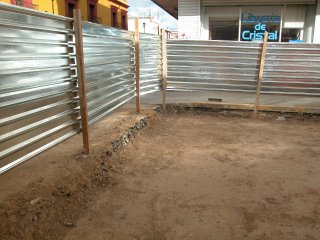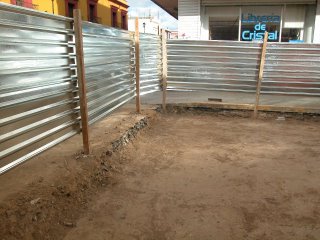Mexico Travelogue
We have been married 34 years and are pretty much an inseparable team. With four children long gone from the nest, we are now contemplating retirement and are travelling more and more in our favourite destination; Mexico. Ultimately we hope to retire in a colonial city in the centre of Mexico and are spending long periods of time in as many as possible. We hope to bring you interesting stories and full articles on life south of the Rio. Please give us your feedback
Thursday, January 26, 2006
Mexican Road Building
Mexican Road Building Techniques
January 26, 2006
For the past few years, the Mexican government has been investing heavily in the Oaxacan infrastructure. Late last year the rebuilding of the Zocalo was completed and by my eye, the results are outstanding. I never did see the original so I can’t say whether it is better or worse but many people wrote to the forum at Mexconnect.com with strong reservations on the final product.
Shortly after our arrival in Oaxaca, reconstruction began on a street two blocks from our apartment. Since I have some experience with subdivision servicing in Canada, I had more than a passing interest in Mexican construction techniques relative to those north of the border. This particular road is just beyond the Zocalo boundaries and the government was converting an asphalt surface to one with cut stones to create historical character. In addition, the sewer and water lines were being replaced.
The first order of business was the removal of the existing asphalt. The equipment used in this process consisted of a small John Deere backhoe/loader, a smaller Bobcat and a pneumatic jackhammer. The jackhammer operator created an opening so the backhoe could begin the process of pulling up the asphalt that was an amazing ten inches thick. The debris was pushed into piles and subsequently loaded into trucks for disposal. Surprisingly quickly the dirt road-base was all that remained.
The next major undertaking was the laying of new sewer and water lines. The John Deere was back at work again digging a trench to lay the pipes. Strangely enough, lines were installed on both sides of the street. The lines were of plastic with the sewer being 8 inches and the water four inches in diameter. Standard manholes were installed every hundred feet for the sewers; however, they were not pre-cast but were manually built with clay brick. Once the piping was done, the trench was backfilled with granular material that was passed through a sieve on site to remove any large stones that could damage the pipes. Except for the trenches being less than four feet deep and the use of more manual labour, the process was not overly different from the Canadian experience.
The reconstruction of the road surface marked a significant departure in the Mexican and Canadian construction techniques. The bobcat was used to scrape the road surface deep enough to accommodate the thickness of the paving stones. This is a pretty rough and ready method since this small machine would bounce over boulders and thus only hint at a final grade. The real work fell to an army of workers equipped with picks, shovels and wheelbarrows. A supervisor strung several chalk lines from one end of the street to the other at the finished grade of the road. The rough grade had to be 12 or so inched lower than the chalk line over the entire surface. Whereas this job would be completed in Canada, in less than half a day by a skilled man in a grader, the process in Mexico involved at least thirty men and took the better part of a week. The final results were about the same but the effort expended in Oaxaca was certainly greater.
It was at this stage that the very interesting task of installing the paving stones began. Dump trucks arrived with loads of quarried granite that was unceremoniously dropped in the middle of the road. The stones had a relatively consistent thickness and were smooth on one side. Otherwise, they were jagged and broken pieces of rock that required cutting and shaping before they would be of any use. About ten men, each with a straight edge, a steel chisel and a maul hammer, took on this arduous task of making useful paving stones from this mass of rubble. It was really quite disconcerting to see the working environment on this job site. There were no hard hats, no work boots and worst of all no eye protection. Shards of broken stone were flying in all directions and you can see by the presence of the lady in the picture, civilians were free to wander the site. You will also note the finished stone at the bottom centre of the photo.
A team of two or three men with wheelbarrows collected the finished stones and hauled them up to the masons as the other end of the job site. Their other task was to collect the debris left by the stonecutters and place it in piles for future removal by truck.
The really interesting part of the road building was the actual laying of the stones. Engineers or supervisors restrung the chalk lines setting the final elevation and crown of the road. Five spines, spaced about four feet apart ran the length of the street. The spines were built with fairly large stones of consistent dimensions and I presume that this job was handled by the master masons. Other masons were employed to fill the spaces between the spines.
The laying of each stone was a laborious task. The stones weren’t merely placed on the ground since the bottoms were too irregular. Rather, they were bedded in mortar mix just as in bricklaying. While one team of men was engaged in laying the stones, another group was busy mixing mortar on sheets of plywood and another team delivered the mortar to the masons. Amazing to me was the consumption of a five-gallon pail of mortar for every stone. The place was a human anthill and I counted 26 men engaged in this task in a thirty-foot length of road.
The design of the road surface was not a simple horizontal pattern but a herringbone and this required more cutting of the stone by the masons at the point of placement.
It was fascinating to go past the site each day and see the entire pattern begin to take shape. These men were excellent craftsmen and very hard working. The task was very time consuming by Canadian standards but I expect this road to have a useful life of a hundred years or more.
January 26, 2006
For the past few years, the Mexican government has been investing heavily in the Oaxacan infrastructure. Late last year the rebuilding of the Zocalo was completed and by my eye, the results are outstanding. I never did see the original so I can’t say whether it is better or worse but many people wrote to the forum at Mexconnect.com with strong reservations on the final product.
Shortly after our arrival in Oaxaca, reconstruction began on a street two blocks from our apartment. Since I have some experience with subdivision servicing in Canada, I had more than a passing interest in Mexican construction techniques relative to those north of the border. This particular road is just beyond the Zocalo boundaries and the government was converting an asphalt surface to one with cut stones to create historical character. In addition, the sewer and water lines were being replaced.
The first order of business was the removal of the existing asphalt. The equipment used in this process consisted of a small John Deere backhoe/loader, a smaller Bobcat and a pneumatic jackhammer. The jackhammer operator created an opening so the backhoe could begin the process of pulling up the asphalt that was an amazing ten inches thick. The debris was pushed into piles and subsequently loaded into trucks for disposal. Surprisingly quickly the dirt road-base was all that remained.
The next major undertaking was the laying of new sewer and water lines. The John Deere was back at work again digging a trench to lay the pipes. Strangely enough, lines were installed on both sides of the street. The lines were of plastic with the sewer being 8 inches and the water four inches in diameter. Standard manholes were installed every hundred feet for the sewers; however, they were not pre-cast but were manually built with clay brick. Once the piping was done, the trench was backfilled with granular material that was passed through a sieve on site to remove any large stones that could damage the pipes. Except for the trenches being less than four feet deep and the use of more manual labour, the process was not overly different from the Canadian experience.
The reconstruction of the road surface marked a significant departure in the Mexican and Canadian construction techniques. The bobcat was used to scrape the road surface deep enough to accommodate the thickness of the paving stones. This is a pretty rough and ready method since this small machine would bounce over boulders and thus only hint at a final grade. The real work fell to an army of workers equipped with picks, shovels and wheelbarrows. A supervisor strung several chalk lines from one end of the street to the other at the finished grade of the road. The rough grade had to be 12 or so inched lower than the chalk line over the entire surface. Whereas this job would be completed in Canada, in less than half a day by a skilled man in a grader, the process in Mexico involved at least thirty men and took the better part of a week. The final results were about the same but the effort expended in Oaxaca was certainly greater.
It was at this stage that the very interesting task of installing the paving stones began. Dump trucks arrived with loads of quarried granite that was unceremoniously dropped in the middle of the road. The stones had a relatively consistent thickness and were smooth on one side. Otherwise, they were jagged and broken pieces of rock that required cutting and shaping before they would be of any use. About ten men, each with a straight edge, a steel chisel and a maul hammer, took on this arduous task of making useful paving stones from this mass of rubble. It was really quite disconcerting to see the working environment on this job site. There were no hard hats, no work boots and worst of all no eye protection. Shards of broken stone were flying in all directions and you can see by the presence of the lady in the picture, civilians were free to wander the site. You will also note the finished stone at the bottom centre of the photo.
A team of two or three men with wheelbarrows collected the finished stones and hauled them up to the masons as the other end of the job site. Their other task was to collect the debris left by the stonecutters and place it in piles for future removal by truck.
The really interesting part of the road building was the actual laying of the stones. Engineers or supervisors restrung the chalk lines setting the final elevation and crown of the road. Five spines, spaced about four feet apart ran the length of the street. The spines were built with fairly large stones of consistent dimensions and I presume that this job was handled by the master masons. Other masons were employed to fill the spaces between the spines.
The laying of each stone was a laborious task. The stones weren’t merely placed on the ground since the bottoms were too irregular. Rather, they were bedded in mortar mix just as in bricklaying. While one team of men was engaged in laying the stones, another group was busy mixing mortar on sheets of plywood and another team delivered the mortar to the masons. Amazing to me was the consumption of a five-gallon pail of mortar for every stone. The place was a human anthill and I counted 26 men engaged in this task in a thirty-foot length of road.
The design of the road surface was not a simple horizontal pattern but a herringbone and this required more cutting of the stone by the masons at the point of placement.
It was fascinating to go past the site each day and see the entire pattern begin to take shape. These men were excellent craftsmen and very hard working. The task was very time consuming by Canadian standards but I expect this road to have a useful life of a hundred years or more.
Evening at the Circus
Evening at the Circus
January 25, 2006
Yesterday we went to the circus. If you are thinking animals, acrobats and clowns, you have the right idea. I haven’t been to a circus since the 1950’s when the Shrine Circus came to town. Such events may now be rare north of the border with the advent of animal rights and the Cirque de Soleil, but they are still alive and well in Mexico.
The Ayade Circus was held on the outskirts of the Oaxaca where they have shopping centres, multiplex cinemas, Sam’s, Kentucky Fried Chicken and Burger King. “Wow, Todto, this must be Kansas.” We had taken a rush hour bus to get to the event for 6 PM. The bus ride was almost as exciting as the circus. The bus was packed and we were in the standing group. We knew immediately that the driver wasn’t paying for maintenance on this bus. All stops were done on a peso while take-offs were the types that usually follow bank robberies. My body was swaying so much that my trick hip went back into the correct position again.
We knew the name of our stop but had not the slightest idea how far we had to travel to find it. Every second minute, I would ask some fellow standee “Is this Plaza de Valle?” Nope and they would point further ahead. At last we saw a sign indicating our destination and off we hopped. Unfortunately we didn’t see anything that resembled a circus, only a shopping centre. Naturally we asked passers by in broken English if they could tell us where the circus was. As is the norm in Oaxaca, I was greeted by vacuous stares. Not to worry; out came the handy dandy electronic translator. “Donde esta el Circo?” Ah, ayi, ayi – over there. And so it was. We could see fluttering flags atop a tent across a twelve lanes of rush hour traffic but with perfectly flexible hips were able to play dodge ball with insane Mexican drivers to reach the other side.
The circus was actually in a tent, a perfectly round tent as a matter of fact. I hoped we could get good seats close to the action and hurried to the ticket wicket. Prices were $20, $15 and $10 US. I wondered how many Mexicans can afford this. I soon found out as the place was darn near empty. We got the front row seats in rows 1 and 2. In other words, we were about to become best friends with every performer, human and animal in the entire circus. To get to our seats, we had to go through three sets of ticket takers. Finally a gentleman dressed in tuxedo escorted us to the correct seats. Nice cushions were placed on the seats but they quickly disappeared when I declined to pay an extra $2 each.
The show began right on Mexican time and was pretty entertaining. There were the usual array of animal acts involving camels, llamas, ponies, dogs, horses and elephants. I have never been as close to an elephant’s ass and it is very large. In fact the beast was having a bladder control problem which was most alarming considering the unnatural positions the animal was forced to take only four feet removed from our seats.
The gymnasts were the most fun. They were very skilled and light hearted in their approach giving the audience a steady stream of laughs. There was a hire wire act that was excellent and several attractive ladies performed extraordinary feast on a thick rope hanging from the ceiling.
In between acts, a clown entertained the crowd and this fellow was a real pro. He involved as many people as possible in his act always seeking some poor soul to humiliate, but always in good fun. If you were a good sport you were given a sucker and everybody went home with one.
So now when people ask me what I did in Mexico, I can say I saw an elephant’s ass up close and had chiropractic treatments on a city bus during rush hour. I will again be treated to vacuous stares and once again think I am back in Oaxaca.
January 25, 2006
Yesterday we went to the circus. If you are thinking animals, acrobats and clowns, you have the right idea. I haven’t been to a circus since the 1950’s when the Shrine Circus came to town. Such events may now be rare north of the border with the advent of animal rights and the Cirque de Soleil, but they are still alive and well in Mexico.
The Ayade Circus was held on the outskirts of the Oaxaca where they have shopping centres, multiplex cinemas, Sam’s, Kentucky Fried Chicken and Burger King. “Wow, Todto, this must be Kansas.” We had taken a rush hour bus to get to the event for 6 PM. The bus ride was almost as exciting as the circus. The bus was packed and we were in the standing group. We knew immediately that the driver wasn’t paying for maintenance on this bus. All stops were done on a peso while take-offs were the types that usually follow bank robberies. My body was swaying so much that my trick hip went back into the correct position again.
We knew the name of our stop but had not the slightest idea how far we had to travel to find it. Every second minute, I would ask some fellow standee “Is this Plaza de Valle?” Nope and they would point further ahead. At last we saw a sign indicating our destination and off we hopped. Unfortunately we didn’t see anything that resembled a circus, only a shopping centre. Naturally we asked passers by in broken English if they could tell us where the circus was. As is the norm in Oaxaca, I was greeted by vacuous stares. Not to worry; out came the handy dandy electronic translator. “Donde esta el Circo?” Ah, ayi, ayi – over there. And so it was. We could see fluttering flags atop a tent across a twelve lanes of rush hour traffic but with perfectly flexible hips were able to play dodge ball with insane Mexican drivers to reach the other side.
The circus was actually in a tent, a perfectly round tent as a matter of fact. I hoped we could get good seats close to the action and hurried to the ticket wicket. Prices were $20, $15 and $10 US. I wondered how many Mexicans can afford this. I soon found out as the place was darn near empty. We got the front row seats in rows 1 and 2. In other words, we were about to become best friends with every performer, human and animal in the entire circus. To get to our seats, we had to go through three sets of ticket takers. Finally a gentleman dressed in tuxedo escorted us to the correct seats. Nice cushions were placed on the seats but they quickly disappeared when I declined to pay an extra $2 each.
The show began right on Mexican time and was pretty entertaining. There were the usual array of animal acts involving camels, llamas, ponies, dogs, horses and elephants. I have never been as close to an elephant’s ass and it is very large. In fact the beast was having a bladder control problem which was most alarming considering the unnatural positions the animal was forced to take only four feet removed from our seats.
The gymnasts were the most fun. They were very skilled and light hearted in their approach giving the audience a steady stream of laughs. There was a hire wire act that was excellent and several attractive ladies performed extraordinary feast on a thick rope hanging from the ceiling.
In between acts, a clown entertained the crowd and this fellow was a real pro. He involved as many people as possible in his act always seeking some poor soul to humiliate, but always in good fun. If you were a good sport you were given a sucker and everybody went home with one.
So now when people ask me what I did in Mexico, I can say I saw an elephant’s ass up close and had chiropractic treatments on a city bus during rush hour. I will again be treated to vacuous stares and once again think I am back in Oaxaca.




